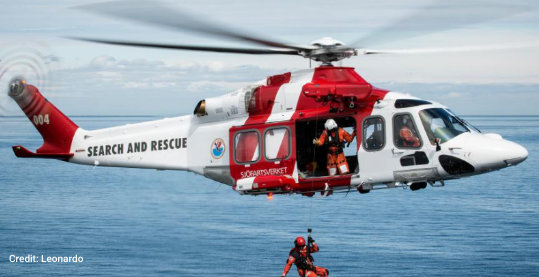Aircraft Overview: Leonardo AW139
Aircraft Overview: Leonardo AW139

Leonardo AW139
The AW139 is a twin-engine helicopter produced by European manufacturer Leonardo.
Originally marketed and certified as the AB139, the helicopter was the result of a collaboration between Leonardo predecessor Agusta and Bell Helicopter, with the AB139 being certified by the Italian Civil Aviation Authority [Ente Nazionale per l’Aviazione Civile (ENAC)] on June 18, 2003.
Despite having different designations, the European Union Aviation Safety Agency (EASA) type certificate data sheet (TCDS) that includes both the AB139 and AW139 states that those types “are two names for the same product.”
According to the EASA TCDS for the AB139 and AW139, the maximum passenger seating capacity of those types is 15, a capacity that Leonardo markets as being a benefit to both energy and security-services operators.
Comparatively, the private and corporate-configured AW139—marketed under the company’s Agusta VIP brand—accommodates as many as 10 passengers.
Described as having avionics which limit the workload of the helicopter’s pilots, the features of the AW139’s avionics include electronic engine control and a four-axis autopilot, both of which are digital.
Additionally, on July 17, 2020, Leonardo announced EASA approval of Honeywell’s Primus Epic integrated avionics system Phase 8 software and an improved enhanced ground proximity warning system (EGPWS), the latter of which is noted as being “optional kit with offshore modes.”
Among the features of that software release are 2D maps which are enhanced and a synthetic vision system (SVS) that is “specifically tailored for helicopter applications.”
Unlock the data behind the charts with Aviation Week Intelligence Network’s Fleet & Data Services. Learn more at aviationweek.com/bcaaircraftoverview.
For a comprehensive Program Profile including recent articles, program suppliers and current operators, please access via AWIN subscription here.
Variants
Powering the AW139 are two Pratt & Whitney Canada PT6C-67C free-turbine turboshaft engines that have full authority digital engine control (FADEC).
Those engines power a five-blade main rotor that is a “fully articulated type,” as well as a tail rotor which has four blades. The helicopter also features tricycle landing gear that can be retracted, while being limited to a 14,110-lb. MGW.
However, the installation of certain kit allows that weight limitation to be increased to 14,991 lb. or 15,432 lb. through a number of changes.
Mission and Performance
As is noted above, the AW139 can serve a number of different types of operators, including helicopter emergency medical services (HEMS), search and rescue (SAR) and VIP, as well as the previously noted energy and security-services operators.
The AW139’s operating limitations include, when “in non-icing conditions,” approval to conduct visual flight rules (VFR) and instrument flight rules (IFR) operations.
Operations in known and limited icing conditions are also allowed when the helicopter is equipped with certain modifications. With regard to the required flight crew, only one pilot is required for operations in day VFR conditions.
However, at night in VFR conditions, in IFR conditions and in known or limited-icing conditions that also involve “IFR operations,” two pilots are required according to the EASA TCDS.
Performance limitations of the AW139 include a never-exceed speed (VNE) of 167-kt. indicated airspeed (KIAS), as well as a maximum operating altitude of 20,000 ft. density or pressure altitude, “whichever comes first.”
Beyond the certified VNE, Leonardo also states that a maximum cruise speed of 165 kt. is possible at maximum continuous power and maximum gross weight (MGW), 5,000 ft. and in International Standard Atmosphere (ISA) conditions.
While maximum continuous power is not one of the criteria assumed for the AW139’s maximum endurance and range—5 hr. 38 min. and 641 nm., respectively—those performance figures are based on most of the same criteria as the maximum cruise speed (ISA, MGW and being operated at 5,000 ft.).
The other criteria which differs between the maximum endurance/range and maximum cruise speed is that an “auxiliary fuel tank – no reserve” is assumed for the former performance figures. Based on takeoff power, MGW and ISA conditions, this Leonardo type can hover out of ground effect (HOGE) at 8,123 ft., a figure that is increased to 15,327 ft. when hovering in ground effect (HIGE).
Leonardo AW139 Images
Aviation Week Network is home to market-leading data and intelligence products. Find out which database is best for your business.
www.aircharterguide.com/
www.aircraftbluebook.com
www.acukwik.com/Products
www.airportdata.com
www.fleet.aviationweek.com